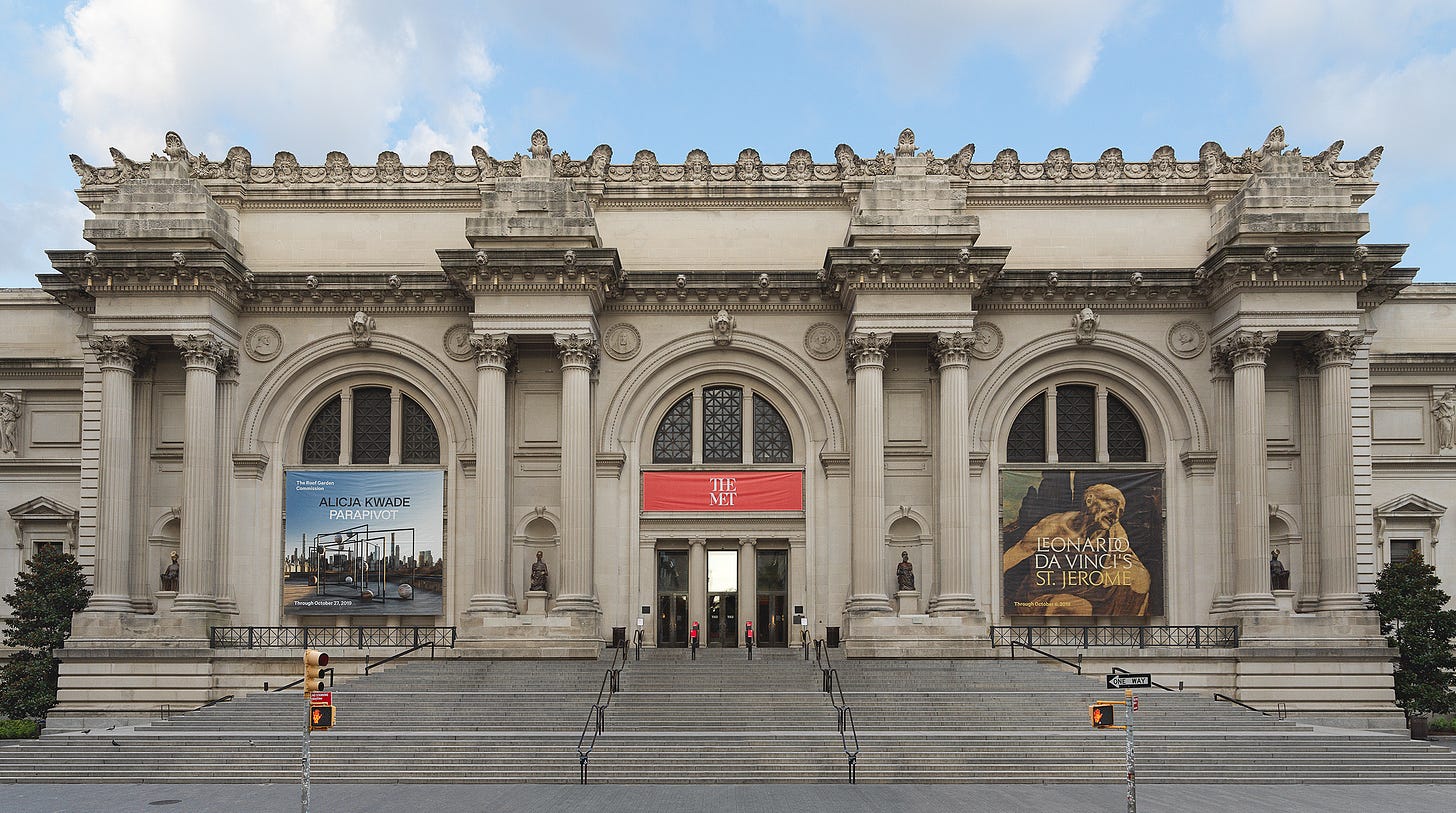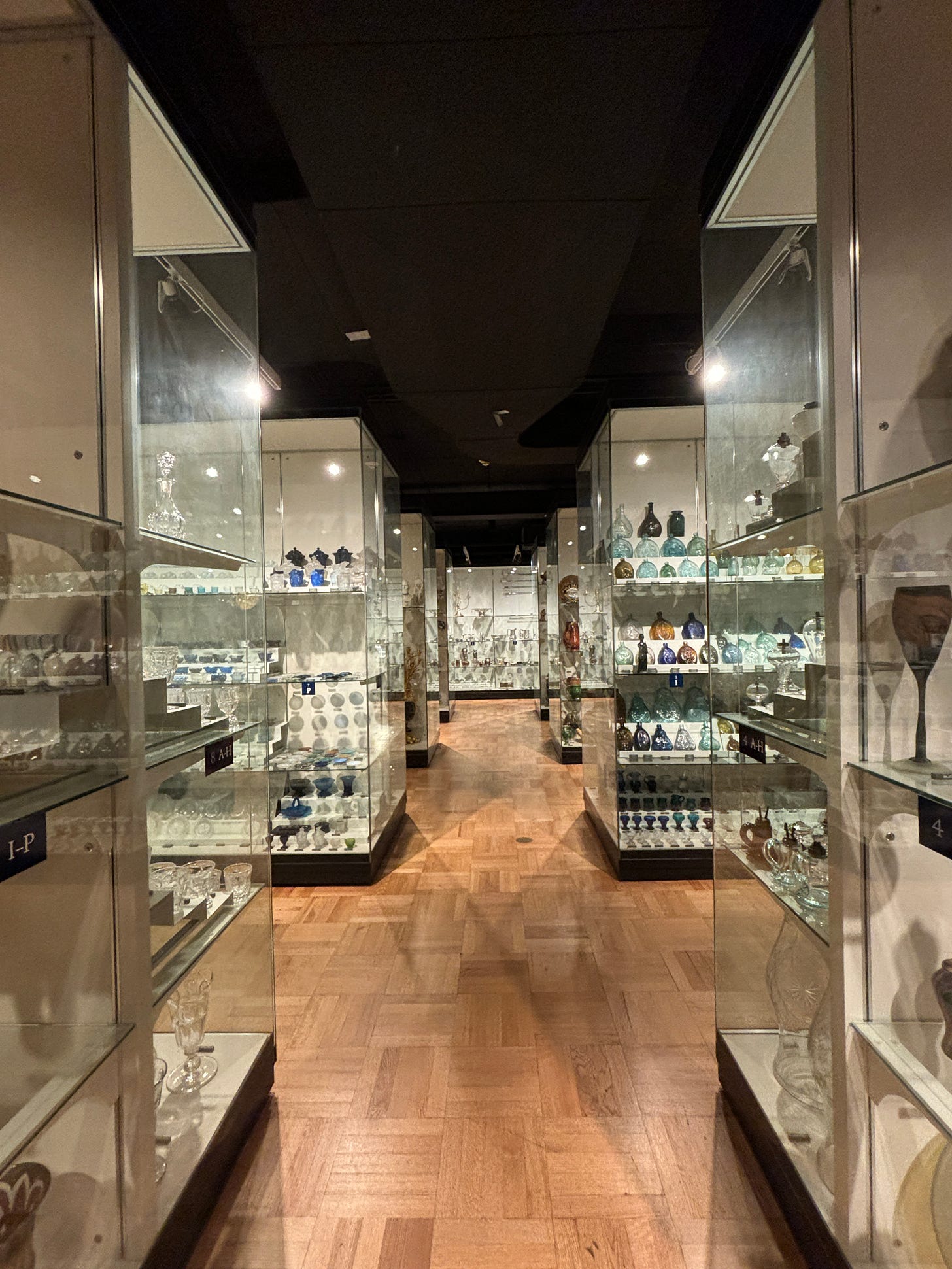Even if you’ve never been to the Metropolitan Museum of Art, you probably know a few things. You know it’s in New York. You know it’s big. And you’ve probably seen people standing or sitting on the front steps that lead up to the main doors. And, if you’ve read From the Mixed-Up Files of Mrs. Basil E. Frankweiler to yourself or to your kids, you might have learned a bit about the inside of the museum.
If you’ve been to the Met, you know that it’s VERY big. You know that it’s easy to get lost. And you know that it can’t all be seen in a day. Well, maybe you could jog through it in a day, but then you’d never see or learn anything.
I didn’t make it to the Met until I was 29. I had been a nanny in London, housekeeper to a priest in Sydney, and a ski bum in Colorado, but hadn’t been to New York. I finally got around to finishing my art history undergraduate degree and applied and been accepted to a grad school program in New York, and my mom and I went on a mini New York adventure so I could see it before I moved there.
My parent loved New York so my mom had been to the Met a few times. Our visit blended a few of her favorite galleries along with some others that neither of us had seen. We wandered and oooed and ahed and chatted, and had lunch.
As a slight aside, or maybe not, this was back in the days when I jogged regularly, usually in the morning. That morning it was raining, and it was my first time in the Big Apple, so instead of jogging I decided to do some stairs in our high-rise hotel. I don’t remember now how many flights I did, but it was a lot – especially for someone who didn’t usually do stairs.
As we were getting ready to leave the Met, I said, “Let’s go down the big staircase!” If you’ve been, or if you’ve seen it, you know it’s wide and long. As we went down, the pain of the morning stair run began to hurt, significantly. I slowly worked my way down, moaning the whole way. My mom said, “It can’t hurt that much. Can you be a little quieter?” It did. And I couldn’t.
Four months later, I started grad school at the Cooper-Hewitt Museum. The library at the Cooper-Hewitt was our study hall. We spread ourselves out at the tables and utilized the resources available for research. However, we often needed more. Our go-to was the Watson Library at the Met. You’ve probably never even noticed the glass door into the library. It’s on the ground floor, near the Great Hall, just to the left of the Grand Staircase. Just so you know for the next time you visit!
The Met is on Fifth Avenue at 83nd Street and the Cooper-Hewitt is on 91st at Fifth Avenue. We would cross Fifth Avenue and walk along the side of Central Park the nine blocks to the Met. This was back in the day when you could pay-what-you-want at the Met. Most of us gave $2 - $5 (this was way back in the 1990s!) each time and didn’t feel bad about it because we were there so often.
I still have very fond memories of the Watson Library and the librarians. So many books! So much help! And, believe it or not, they used to let me go downstairs into the stacks. I don’t remember if all of us from the Cooper-Hewitt were allowed to do that. Nor do I know why that was allowed. Maybe they were just annoyed by how many books they had to retrieve for me! When I was down in the stacks, I felt like I was in a church. A holy space! Row after row of amazing resources!
In addition to going to the Met to use the library, we were often given class assignments to go to the Met and find… Or, go and look for an example of… And, one time we had a class at the Met taught by the head of the American Wing.
After graduating from the Cooper-Hewitt/Parsons School of Design MA program, I then did my internship at the Met. A delightful behind-the-scenes learning experience. I write about that experience in Biltmore Reflections: My Internship at the Met.
I still delight in returning to New York and always visit the Met.
A few years back, I went to New York to see a specific exhibit at the Met, Public Parks, Private Gardens: Paris to Provence. It was a lovely blending of paintings, artifacts, drawings, photographs, and video sharing about the intersection of 19th century art, gardens, parks, recreation, and more. While there, I saw what might be one of my favorite exhibits of all time, Visitors to Versailles (1682–1789). It explored French culture from clothing, meals, music, travel, and more. The best part was the audio tour which included voices, music, clinking of silverware, splashing of fountains, and clip clopping of horses. So well done!
Facts About the Met
The Met is the largest museum in the United States and spans over 2 million square feet and houses more than 1.5 million works of art.
It was founded in 1870 by a group of businessmen, artists, and philanthropists, who created the museum to bring art and art education to the American people. This was different to major museums being founded in 19th century Europe which were started by royalty and aristocracy.
Its collections are encyclopedic spanning 5,000 years and includes masterpieces from ancient Egypt, European painting, Islamic art, African sculpture, and Asian ceramics, as well as two of my favorites, European decorative arts and American decorative arts. And then there’s the textiles, and the… well, it goes on and on!
In 2024 the Met welcomed 5.7 million visitors. No wonder it’s always so loud in the Great Hall!
It offers over 30 special exhibitions each year along with lectures, concerts, and more.
Hospitality
Even though many of us think of New Yorkers as a bit brusque, in a hurry, and opinionated, when they work or volunteer at the Met, much of that is softened in providing a pleasant visitor experience. Not everyone, but most! Hospitality also includes coat checks, clean restrooms, multiple seating options, and several choices for food. They do a good job with wayfinding, providing various tools for visitors to maneuver throughout the massive museum. There are signs, paper maps, and the Met app. The app, called “The Met,” includes an interactive floor plan, an audio guide, exhibit info, collection highlights, and more. You will get lost! You will need to ask for directions, even if you have a decent sense of direction. Ask for help and the guards or front desk staff will be helpful and guide you on your way.
Storytelling
The Met shares details about their collection through labels, audio insights about individual objects, guided tours, and audio tours for special exhibits and collections. Stories might focus on individual pieces of art, the culture they came from, the materials, how they were used, and more. Everything is extremely well researched!
As you may know, artifact labels are a constant source of annoyance for me! They’re often very pedantic, don’t answer the most obvious questions, use tiny fonts, or put the most compelling info at the end. Yes, some of the Met labels are rather hoity toity sounding and some are even a bit boring. “The blue-and-white decorative scheme of this plate is a clear illusion to Chinese porcelains decorate in this manner…” But others are more intriguing, more visitor-focused. And this one even mentions feelings! “Anxiety and Hope in Japanese Art. We often look to art as a source of hope in the face of uncertainty, harnessing this power even as we navigate fears as complex as those relating to death…”
Wellness opportunities
Improving our wellbeing comes from exposure to awe and wonder, curiosity, creativity, relaxation, and more. All of these can be found in abundance during your time at the Met. I call these unplanned or unintentional wellness opportunities. As for planned wellness opportunities, they do have a few programs. And, during the pandemic they created a website page called “Art for Our Well-Being” showing about 5 or 6 objects with descriptions that shared connections to each piece and wellness. However, throughout the museum, there does not appear to be any obvious wellness connections.
How to visit
You cannot see the whole museum in one visit. When I was there last year I allocated a full day and even moving at a fast pace, I didn’t see everything. Before visiting, create at least the framework of a plan. Look at the floor plans online. Check out the special exhibits. Add at least one favorite category of art and one that you want to learn more about. Then when you arrive, chat with the volunteers at the welcome desk and ask for their input. If you’re visiting with friends or family, consider how you’ll address everyone’s interests. And be sure to allocate time for a bit to eat, and opportunities to sit and contemplate art, or even just people watch.
Susan’s Favorites
In case you need a few suggestions to get you started, I’m sharing a few of my favorite permanent galleries.
Medieval Art
The Temple of Dendur
American Wing, Decorative Arts (furniture, porcelain, silver, textiles)
European Sculpture and Decorative arts
The Astor Chinese Garden Court
Open storage in the American Wing
Mission
The Metropolitan Museum of Art collects, studies, conserves, and presents significant works of art across time and cultures to connect all people to creativity, knowledge, ideas, and one another.
If you’re familiar with the Met, what do you always search out? If you’ve never been, what might put on your list when you go?








Susan, what an enjoyable read! So many things to look for when you’re there that you otherwise would never know. Unfortunately, I have never had the pleasure of visiting this incredible museum but it’s definitely on my bucket list now! Thank you for such a informative article!